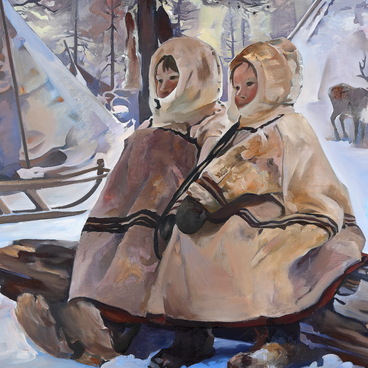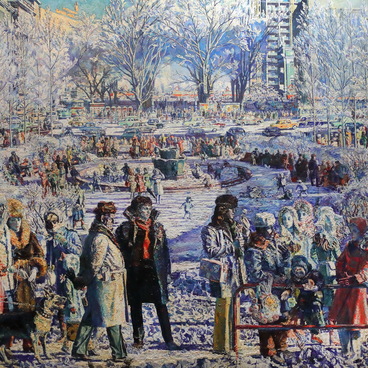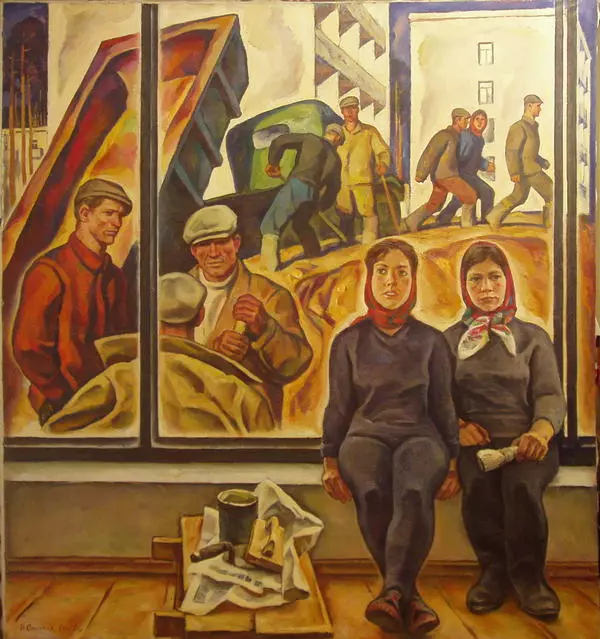Igor Ivanovich Simonov was an outstanding Ural painter and teacher, who was awarded the People’s Artist of the Russian Federation. His establishment as a talented artist took place in the late 1950s. By the 1960s, Simonov’s career was at the height of activity. The art of that time welcomed a new movement that was named “the austere style” based on the term that had been introduced by the Soviet art critic Aleksandr Kamensky. The artist Pyotr Ossovsky, who belonged to the austere movement, said that his colleagues strove to show all realities of life without any embellishment.
The austere style found its way into many genres of the Ural art. During that period, artists revisited the themes of history and revolution. The heroic canvases of those years were distinguished by the attempt to minimize the importance of visual aspects and convey the spiritual atmosphere, drama, and romantic appeal of the time rather than depict specific episodes of history. Simonov’s work “Vasily Blyukher” also belongs to the genre combining allusions to history and revolution.
Vasily Konstantinovich Blyukher was a military commander, a party official, and Marshal of the Soviet Union. He took an active part in the Russian Civil War, where he proved his talent as a commander. He was awarded two Orders of Lenin, five Orders of the Red Banner, the Order of the Red Star, and other medals. Many cities of the former Soviet Union, including Yekaterinburg, have streets named after Blyukher.
Vasily Blyukher is one of the recognizable personalities of the era. In his work, Simonov chose to portray the commander the way he had been in his youth. The hero depicted in the picture radiates perfect composure and alertness, which is one of the main characteristics of the “austere style”. His posture is tense; he holds the handle of a cold weapon with one hand, while the other is clenched into a fist. There is the Order of the Red Banner on Vasily Blyukher’s chest, which he had been one of the first to receive in 1918. Next to their commander are a drummer and a trumpeter who set the mood for a decisive offensive by the “Reds” following their leader. The image of the standard-bearer on a horse enhances the effect of movement.
This work also embodied other characteristic features of the “austere style”: a basic composition, harsh edges, generalized and concise imagery, expressive and bold color usage, and simplified modeling of forms. The works of the “austere style” immersed the audience into the pictorial space by making the composition face the viewer. Large figures were graphically outlined and sculpted with the use of contrasts for the greater glorification of the characters.
The austere style found its way into many genres of the Ural art. During that period, artists revisited the themes of history and revolution. The heroic canvases of those years were distinguished by the attempt to minimize the importance of visual aspects and convey the spiritual atmosphere, drama, and romantic appeal of the time rather than depict specific episodes of history. Simonov’s work “Vasily Blyukher” also belongs to the genre combining allusions to history and revolution.
Vasily Konstantinovich Blyukher was a military commander, a party official, and Marshal of the Soviet Union. He took an active part in the Russian Civil War, where he proved his talent as a commander. He was awarded two Orders of Lenin, five Orders of the Red Banner, the Order of the Red Star, and other medals. Many cities of the former Soviet Union, including Yekaterinburg, have streets named after Blyukher.
Vasily Blyukher is one of the recognizable personalities of the era. In his work, Simonov chose to portray the commander the way he had been in his youth. The hero depicted in the picture radiates perfect composure and alertness, which is one of the main characteristics of the “austere style”. His posture is tense; he holds the handle of a cold weapon with one hand, while the other is clenched into a fist. There is the Order of the Red Banner on Vasily Blyukher’s chest, which he had been one of the first to receive in 1918. Next to their commander are a drummer and a trumpeter who set the mood for a decisive offensive by the “Reds” following their leader. The image of the standard-bearer on a horse enhances the effect of movement.
This work also embodied other characteristic features of the “austere style”: a basic composition, harsh edges, generalized and concise imagery, expressive and bold color usage, and simplified modeling of forms. The works of the “austere style” immersed the audience into the pictorial space by making the composition face the viewer. Large figures were graphically outlined and sculpted with the use of contrasts for the greater glorification of the characters.




